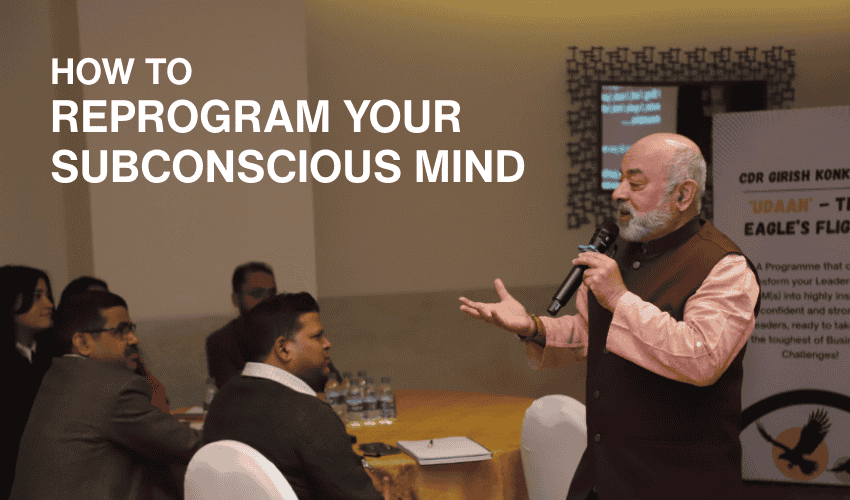
I’ve coached founders, CXOs, and first-time managers who could run a P&L to the last
decimal, yet felt stuck in patterns they couldn’t explain. Not a strategy issue. A
subconscious one. Your subconscious is the silent operating system under every choice,
emotion, and reaction. If
you want sustainable change, don’t just work harder, work deeper.
Lets try and answer the question today : what is subconscious mind ? How it interacts
with the conscious, and a clear, actionable path on how to control the subconscious mind
and how to start reprogramming subconscious mind, the way professionals do it.
What is Subconscious Mind: The Engine Behind Your Automatic Decisions
If the conscious mind is the driver, the subconscious is the engine. You don’t always see
it, but it powers everything. Habits, biases, fears, impulses, confidence, most of it runs
below awareness. That’s why willpower alone cracks by Wednesday; the subconscious keeps
pulling you back to baseline.
A senior sales leader told me, “I know what to say in big meetings, but my voice tightens.”
Not a skill gap, a subconscious association formed years ago when a mentor publicly
criticized him. Once we surfaced that memory and rewired the meaning, his “stage fear”
dissolved. Skill wasn’t the fix. Subconscious work was.
Leadership takeaway: Change your inner script, your outer results follow.
That’s the essence of reprogramming subconscious mind.
What is Subconscious Mind and Conscious Mind: Two Systems, One Outcome
Your conscious mind sets goals: “I’ll wake at 5 a.m., eat clean, speak up.”
Your subconscious mind sets the rules: “Early mornings are painful,” “I’m not good enough,”
“Visibility is risky.”
When they disagree, the subconscious wins. Every. Single. Time.
To align both, you must (1) surface the hidden rules, (2) question them, and (3) replace
them with upgraded beliefs. This is not wishful thinking; it’s structured mental
conditioning backed by repetition and emotion.
Remember the power of belief: the brain takes repeated, emotionally charged instruction
seriously. That’s how identity shifts happen.
How to Control the Subconscious Mind: Daily Practices That Actually Work
Control doesn’t mean suppressing thoughts. It means guiding attention and emotion so the mind learns a new default.
Five practices I teach leaders:- Identity Statements (AM/PM):
Write 3 “I am” statements that reflect who you’re becoming, not who you’ve been. Example: “I am a calm, decisive leader.” Read slowly, breathe, visualize. (2 minutes) - Emotion Tagging:
When anxiety spikes, label it out loud: “This is anxiety.” Labelling moves activity from the amygdala to the prefrontal cortex, calm follows clarity. - Mental Rehearsal:
Before a high-stakes event, close your eyes and rehearse the ideal outcome: tone, timing, body language. The brain encodes rehearsal like a real rep. - Trigger Mapping:
List your top three triggers (e.g., criticism, delays, ambiguity). For each, script a one-line response you’ll use next time. Practice it daily. This is how to control the subconscious mind under pressure. - Night Audit:
Before sleep, replay one win from the day, even tiny. End with one sentence about tomorrow: “Tomorrow I act with clarity and ease.” Sleep is when updates install.
These are small but surgical. Over weeks, they change the “rules” your subconscious runs.
Reprogramming Subconscious Mind: A Step-by-Step Protocol
Here’s a compact loop I use in workshops:
- Spot the Pattern –
“When X happens, I do Y.” - Find the First Memory –
When did this first feel true? (You’ll be surprised.) - Reframe the Meaning –
What else could that event have meant? Choose a stronger interpretation. - Install the New Belief –
Turn it into a present-tense statement and pair it with breath + visualization. - Reinforce with Action –
Take a small behavior that proves the new belief today.
Repeat the loop for 21–30 days. That’s reprogramming subconscious mind with intention, not
hope.
A leader once told me, “I don’t have the big picture.” We built a 10-minute evening ritual:
review priorities, write tomorrow’s top 3, visualize outcomes. In 3 weeks, his team called
him “the most strategic he’s ever been.” Nothing mystical, just structured mental updates.
That’s the quiet power
of vision at work (and yes, the power
of belief too).
How to Reprogram Your Subconscious Mind: A 30-Day Challenge
If you want a straight path, here’s how to reprogram your subconscious mind in one month:
- Days 1–3: Awareness Sprint
Journal triggers, recurring self-talk, and peak-energy moments. Name the old script. - Days 4–10: Design the New Script
Write 5 identity statements. Record them in your voice. Listen morning and night. - Days 11–20: Rehearse + Act
Daily visualization (3 minutes). One small behavior that matches the new identity (speak up once, delegate one task, start one hard thing). - Days 21–30: Stabilize Under Stress
Use emotion tagging + trigger mapping during tough moments. Track recovery time — it should drop.
By Day 30, you won’t be “done.” You’ll be different. And this difference will compound.
Conclusion: The Mind You Train Is the Life You Lead
If you understand the subconscious mind, practice how to control the subconscious mind, and
commit to reprogramming your subconscious mind, you’ll rewrite outcomes that once felt
“fixed.” This is how to reprogram your subconscious mind, with clarity, repetition, and
aligned action.
In leadership and in life, results follow identity. Upgrade the identity, and the results
catch up. That’s not magic, that’s discipline applied to the most powerful system you own:
your mind.
About Coach Girish Konkar
Cdr.
Girish Konkar (Retd.) is a former Indian Navy Submarine Commander turned Leadership
& Transformation Coach with over 40 years of experience across military and corporate
arenas.
As CEO of Beyond Horizons, he blends experiential tools like NLP, Psych-K®, etc. with
strategic insight to empower authentic, resilient leaders. He now dedicates his journey to
guiding professionals and organizations toward purposeful leadership, growth, and lasting
impact.





